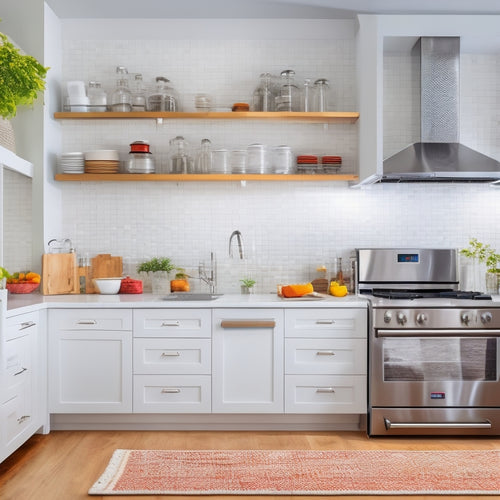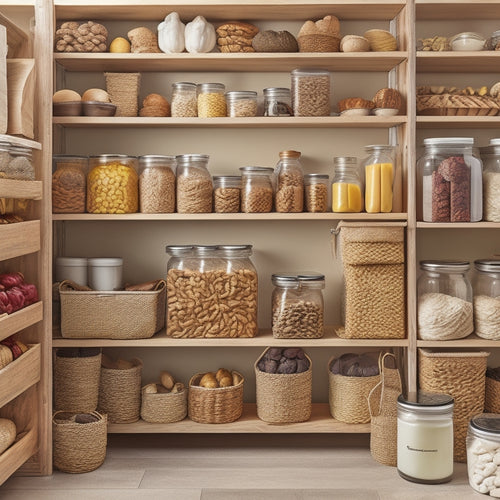
Knife Guide: Choose Right Blade for You
Share
When selecting the appropriate knife, consider the specific cutting tasks you'll be performing, as different knives are designed for distinct purposes. Key features such as handle material, weight distribution, and blade material influence the knife's performance, comfort, and maintenance. Blade length and shape also affect versatility and control. With various materials like Damascus steel and ceramic, and edge types available, it's crucial to choose a knife that aligns with your needs and maintenance routine. By comprehending these factors, you can find a well-suited knife that enhances your cooking experience; now, explore the nuances of each to find your perfect fit.
Key Takeaways
• Consider the specific cutting tasks you'll be using the knife for and choose a design that suits those needs.
• Select a handle material that provides a comfortable grip and is easy to maintain, such as wood or polymeric materials.
• Balance and weight distribution are crucial, as they impact maneuverability, control, and fatigue reduction.
• Choose a blade material and edge type that align with your maintenance routine, such as Damascus steel or ceramic blades.
• Select a blade length that complements your hand size and the tasks you'll be performing, ensuring a secure grip and optimal performance.
Essential Knife Types Explained
The five essential knife types that form the foundation of any well-stocked kitchen are the Chef Knife, Santoku Knife, Utility Knife, Nakiri (Vegetable) Knife, and Paring Knife, each designed to excel in specific cutting tasks.
When selecting a knife, consider maintenance tips such as regular sharpening and cleaning to ensure best performance. Brand comparisons can also be helpful, with reputable brands like Tojiro and Shun offering high-quality options.
Additionally, handle materials, such as ergonomic designs and durable materials, can impact the overall user experience. Mastering sharpening techniques is also important, as a dull knife can be hazardous.
Key Features to Consider
When selecting a knife, understanding the key features that define each type is important, as the right combination of characteristics can greatly impact performance and overall user experience.
Handle material, for instance, affects grip comfort, durability, and maintenance. Common materials include wood, metal, and synthetic materials, each with its unique advantages and disadvantages.
Weight distribution is another vital factor, as it influences balance, maneuverability, and control. A well-balanced knife with best weight distribution enables precise cuts and reduces fatigue.
Additionally, consider the blade's material, edge type, and sharpening requirements to guarantee a seamless cutting experience.
Choosing the Right Size
In the world of knife selection, blade length is a critical consideration, as it directly impacts the knife's versatility, maneuverability, and overall performance. A knife that is too large or too small can be unwieldy and compromise control.
To choose the right size, consider the following factors:
-
Blade length and hand size: A knife with a blade length that complements your hand size ensures a comfortable grip and effortless maneuverability.
-
Knife weight and grip comfort: A well-balanced knife with an ideal weight distribution ensures a secure grip, reducing fatigue and strain during extended use.
-
Task-specific requirements: Different tasks require specific blade lengths, such as a longer blade for chopping and a shorter blade for precision work.
Blade Shapes and Materials
Various blade shapes and materials are meticulously crafted to enhance performance, durability, and user experience, making it essential to understand their distinct characteristics and applications.
Japanese designs, such as the Nakiri knife, feature straight-edged blades ideal for precise vegetable cuts.
In contrast, Western designs often incorporate curved blades, as seen in Chef and Utility knives, which facilitate smooth cutting motions.
Materials also vary, with Damascus steel offering exceptional sharpness and durability, while ceramic blades provide rust-resistance and lightweight construction.
Understanding these differences enables users to select the best blade for their specific needs, ensuring precision, control, and efficiency in their culinary pursuits.
Selecting the Perfect Fit
With a deep understanding of blade shapes and materials, selecting the perfect fit for a specific task or personal preference is the next logical step in optimizing kitchen performance.
A well-suited knife can elevate cooking experiences and reduce fatigue. To achieve this harmony, consider the following factors:
-
Blade maintenance and sharpening: Confirm the knife's material and edge type align with your maintenance routine and sharpening skills.
-
Ergonomic handles and grip: Choose a handle that fits comfortably in your hand, reducing fatigue and improving control.
-
Task-specific design: Select a knife tailored to your primary tasks, such as chopping, slicing, or mincing, to optimize performance and efficiency.
Frequently Asked Questions
Can I Use a Chef Knife for Tasks That Require Precision?
While a chef knife can handle various tasks, precision tasks may be better suited for a santoku knife, as its slender design and curved belly facilitate precise cuts.
Are Santoku Knives Suitable for Cutting Through Bones?
Santoku knives are not suitable for cutting through bones, as they are designed for precision tasks like chopping, dicing, and mincing, not bone sawing, which requires a more robust and specialized tool.
Do Utility Knives Make Good Alternatives to Chef Knives?
Seventy-five percent of professional chefs prefer utility knives for daily tasks due to their versatility. While they can't replace chef knives for heavy-duty chopping, utility knives excel in ergonomics and blade length, making them a suitable alternative for general-purpose cutting and slicing.
Are Nakiri Knives Only Meant for Chopping Vegetables?
While Nakiri knives excel at chopping vegetables, their straight blade edge and precision cutting capabilities also make them suitable for other tasks, showcasing exceptional knife versatility and adaptability to various cutting techniques.
Can Paring Knives Be Used for Cutting Meat?
'As we explore the domain of precision cutting, a question arises: can paring knives be used for cutting meat? While not perfect for thick cuts, paring knives' versatility shines in delicate meat slicing, highlighting the importance of blade selection for best results.'
Related Posts
-

Optimize Your Kitchen Storage With 7 Simple Hacks
You're already wasting valuable kitchen space without realizing it, and it's likely due to a lack of strategic storag...
-

10 Essential Storage Solutions for Bulk Food Storage
You're taking the first step towards maximizing your pantry's potential! Start with airtight containers for dry goods...

